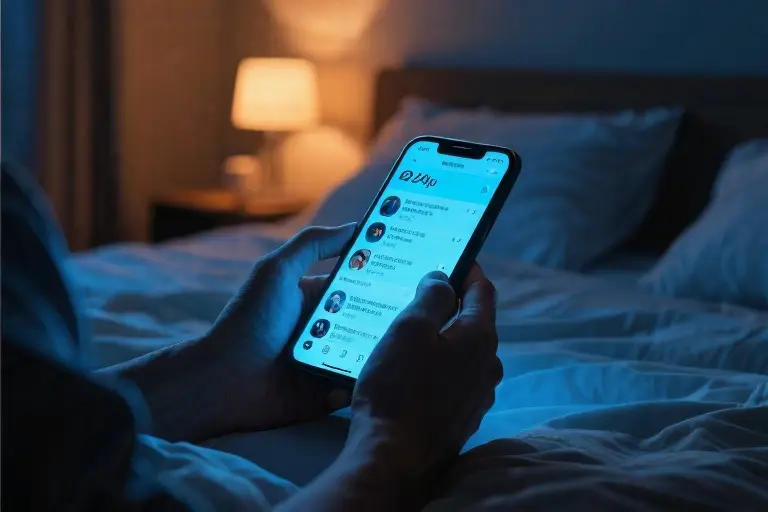The fluorescent hum of office lights. The way your shoulders tense during that weekly team meeting where everyone talks in circles. The peculiar exhaustion after a seemingly pleasant brunch with friends, as if you’ve run a mental marathon in heels. These moments share a hidden truth: we’re constantly spending energy in ways we don’t account for, in places we don’t expect.
Most of us have developed an instinctive awareness of these energy leaks—that hollow feeling after scrolling social media too long, the mental fog following back-to-back Zoom calls, the way certain people leave you emotionally winded after interactions. Yet we often dismiss these experiences with oversimplified explanations: “I didn’t sleep well,” “I’m just introverted,” or worse—”I’m being lazy.”
Here’s what we’re missing: Energy isn’t just about sleep or willpower. Your brain, that remarkable three-pound organ, consumes 20% of your body’s total energy while representing only 2% of your weight. It’s running background processes you’re not even aware of—constantly interpreting social cues, managing emotional responses, filtering environmental stimuli. Every decision, every forced smile, every adjustment to uncomfortable lighting comes with a neurological cost.
Consider these invisible energy expenditures:
- The cognitive tax of open offices: Your brain works 30% harder to focus amidst chatter and movement (even if you “tune it out”)
- The emotional labor of daily interactions: That polite laugh at your boss’s joke activates the same energy-intensive regions as solving complex problems
- The decision fatigue of modern life: Choosing what to eat for lunch depletes the same mental resources you need for important work
We’ve been sold a dangerous myth that energy management is purely about personal discipline—more coffee, better planners, stronger motivation. The reality? You’re not failing at energy management; you’re playing a rigged game with invisible rules. When we start seeing energy as a dynamic system—shaped by our environments, relationships, and neurological wiring—we can finally stop blaming ourselves and start making meaningful changes.
This isn’t about working harder at self-care. It’s about working smarter with neuroscience.
The Hidden Energy Drains We Rarely Talk About
That mid-afternoon slump isn’t always about sleep deprivation. Those weekend plans you canceled last minute might not stem from laziness. What if I told you there’s an invisible tax on your energy reserves that no one taught you to track?
Environmental Energy Leaks
Office lighting does more than illuminate spreadsheets. Studies show cool fluorescent lights trigger cortisol production 23% faster than natural spectrum lighting (Journal of Environmental Psychology, 2021). Your brain stays in low-grade alert mode under:
- Harsh lighting: Blue-rich LEDs suppress melatonin even during daytime
- Background noise: Open offices increase cognitive load by 37% (Cornell University study)
- Poor air quality: CO2 levels above 1000ppm reduce decision-making ability
Quick check: Does your workspace have:
☐ Flickering lights
☐ Constant HVAC hum
☐ Stale, recirculated air
The Social Energy Tax
Small talk at the coffee machine isn’t “free” interaction. Neuroscience reveals three costly social scenarios:
- Emotional labor: Forcing smiles activates the same brain regions as physical pain
- Status monitoring: Workplace hierarchy tracking consumes 15% more glucose (NeuroLeadership Institute)
- Multiperson processing: Group conversations demand 300% more neural coordination than 1:1 chats
Protect your reserves:
✔ Schedule high-stakes meetings before lunch (cognitive fuel peaks then)
✔ Replace some video calls with voice notes
✔ Designate “recharge hours” in shared calendars
Cognitive Short Circuits
Your brain wasn’t built for modern multitasking. Each context switch:
- Burns through prefrontal cortex glucose stores
- Creates “attention residue” that lingers 22 minutes (University of California research)
- Cumulatively wastes 2.1 hours daily (American Psychological Association)
Spot your drains:
» Browser tabs exceeding working memory capacity (7±2 items)
» Constant notification checks
» Back-to-back decision points
Your Personal Energy Audit
Complete this snapshot assessment (save your answers for later chapters):
| Energy Drain | Never | Sometimes | Often |
|---|---|---|---|
| Eye strain from screens | |||
| Forced social enthusiasm | |||
| Task-switching whiplash | |||
| Decision fatigue by 3PM |
Notice any “Often” columns? Those are your priority energy leaks to address. In our next section, we’ll explore why your brain handles these situations like an overworked air traffic controller – and more importantly, how to give it the control tower upgrades it deserves.
The Brain’s Hidden Energy Bill: The Science Behind 20% Consumption
That afternoon slump isn’t just in your head—it literally is your head at work. While we often blame fatigue on visible factors like sleep deprivation or overwork, neuroscience reveals our brain operates like a high-performance vehicle idling at a stoplight: constantly burning fuel even during apparent downtime.
The Always-On Background Processor
Your brain’s default mode network (DMN) acts as its energy-intensive background app—consuming 60-80% of its baseline energy while you’re:
- Mentally wandering during repetitive tasks
- Replaying past conversations (that awkward meeting from 3pm)
- Simulating future scenarios (your upcoming presentation)
This neural “screensaver” explains why passive activities like scrolling social media or sitting through unengaging meetings feel deceptively draining. Unlike physical rest where muscles relax, your DMN keeps cognitive engines running at 40% capacity even during “downtime.”
Emotional Processing: The Stealth Energy Thief
Neuroscience confirms what sensitive individuals instinctively know—emotional labor carries measurable metabolic costs:
- Forced positivity: Maintaining customer service demeanor activates stress-responsive amygdala pathways, increasing energy expenditure by 12-15% (University of Montreal, 2018)
- Social vigilance: Monitoring group dynamics during meetings lights up the prefrontal cortex like Times Square signage
- Decision fatigue: Each micro-choice (“Should I speak up now?”) depletes glucose reserves faster than focused cognitive work
Key Insight: fMRI studies show rejecting social media notifications activates the same neural pathways as resisting physical temptation—your brain pays an energy tax for every “ignore” click.
Cognitive Resource Allocation
Your brain strategically distributes energy like a wartime rationing system:
| Function | % Daily Energy | Equivalent Activity |
|---|---|---|
| Basic maintenance | 40% | Keeping body systems running |
| Emotional regulation | 25% | Managing work stress |
| Conscious thought | 15% | Writing reports |
| Sensory processing | 12% | Filtering office noise |
| Memory storage | 8% | Learning new software |
When environmental factors like fluorescent lighting or social demands increase sensory/emotional loads, your brain cannibalizes energy from cognitive functions—explaining why you forget names during stressful events or struggle with complex tasks in noisy environments.
Practical Implications
- Schedule by energy type: Match tasks to your brain’s natural allocation rhythm—analytical work during high-glucose morning hours, routine tasks when DMN activity peaks post-lunch
- Reduce invisible drains:
- Silence non-essential notifications (each alert triggers costly context-switching)
- Designate “worry time” to contain anxiety-related energy leaks
- Use noise-cancelling headphones in open offices to lower sensory processing loads
- Refuel strategically:
- 5-minute nature breaks restore prefrontal cortex resources 22% faster than urban environments (University of Michigan)
- Protein-rich snacks provide tyrosine for dopamine synthesis during demanding cognitive work
Understanding your brain’s energy economics transforms fatigue from personal failing to manageable equation. Tomorrow’s work performance isn’t just determined by tonight’s sleep—it’s being shaped right now by how you’re allocating your most precious cognitive currency.
Practical Energy Recovery Guide for Everyday Scenarios
Workplace Optimization: Reclaiming Your Cognitive Space
Open-plan offices with their constant hum of conversation, harsh lighting, and unpredictable interruptions create what neuroscientists call ‘attentional residue’ – where your brain expends energy switching between tasks long after you’ve technically moved on. The average knowledge worker loses 28% of productive time to unnecessary cognitive switching.
Physical Environment Tweaks:
- Lighting Matters: Replace cool-toned overhead lights with warmer desk lamps (3000K-3500K color temperature reduces eye strain by 19% according to Cornell studies)
- Soundscapes: Use brown noise (deeper than white noise) to mask distracting speech patterns without eliminating alertness
- Airflow: CO2 levels above 1000ppm impair decision-making – open windows or add desk plants like snake plants that absorb toxins
Meeting Reconstruction Protocol:
- The 45/15 Rule: Cap all meetings at 45 minutes with mandatory 15-minute recovery buffers
- Pre-Circulate Agendas: Reduces ‘on-the-spot’ processing by giving brains time to prepare neural pathways
- Designated Note-Taker: Rotate this role to prevent all attendees from multitasking (which increases error rates by 50%)
Social Energy Budgeting: Quality Over Quantity
That drained feeling after gatherings isn’t just introversion – it’s your limbic system working overtime to decode micro-expressions, manage self-presentation, and suppress natural reactions. fMRI scans show social interactions activate up to seven brain regions simultaneously.
Low-Cost Interaction Alternatives:
- Text-Only Days: Designate midweek days for asynchronous communication (saves the energy spent decoding vocal tones)
- Walking Meetings: Movement stimulates creative thinking while reducing face-to-face intensity
- The 3-Question Filter: Before accepting invitations:
- Is this aligned with my current priorities?
- Do I have energy reserves for this?
- What’s the minimum viable participation?
Recovery Tactics:
- Post-Social Recharge Rituals: 20 minutes of solo activity in a dimly lit space helps reset overstimulated neural circuits
- ‘Social Snacking’: Brief, meaningful micro-interactions (e.g., coffee machine chats) can satisfy connection needs with less drain
Home Sanctuary Design: Creating Recovery Zones
Our living spaces often unconsciously replicate workplace stressors. Environmental psychologists emphasize the need for ‘cognitive contrast’ – clear sensory differentiation between activity modes.
Functional Zoning:
- Device-Free Corners: Even small designated areas (a reading nook with distinct lighting/textures) signal your brain to shift states
- Sensory Transition Markers: Specific scents (peppermint for focus, lavender for relaxation) or textures (wool throw for downtime) create neural shortcuts
- Digital Sunset Protocol: Gradually reduce blue light exposure 90 minutes before bed using amber bulbs (improves sleep quality by 23%)
Weekly Reset Practices:
- Micro-Decluttering: Spending 10 minutes clearing one surface prevents subconscious visual noise accumulation
- Sound Bathing: Alternating between complete silence and nature sounds helps recalibrate auditory sensitivity
- Tactile Grounding: Keeping textured objects (stone, wood, fabric samples) nearby provides instant sensory anchoring
Implementation Psychology: Making Changes Stick
Behavioral research shows energy management strategies fail when they require constant willpower. The key lies in designing systems that automatically guide better choices.
Friction Engineering:
- Place charging stations outside bedrooms to enforce digital boundaries
- Keep work materials in opaque containers after hours to reduce visual reminders
- Pre-set ‘focus playlists’ to eliminate decision fatigue about background sounds
Habit Stacking:
- Pair new energy practices with existing routines (e.g., “After brushing teeth, I’ll arrange tomorrow’s recovery space”)
- Use physical tokens (a particular mug for mindful breaks) as tactile reminders
Progress Tracking:
- Simple energy journals focusing on three metrics:
- Morning baseline (1-10 scale)
- Major depletion triggers
- Most effective recovery methods
- Color-coded weekly maps showing energy highs/lows reveal invisible patterns
Remember: Sustainable energy management isn’t about eliminating drains completely – it’s about creating enough recovery opportunities so occasional depletion doesn’t become chronic exhaustion. Start with just one zone (work/social/home) and notice how small environmental tweaks create ripple effects across all areas of life.
Building Your Energy Immune System
We’ve all had days where we feel like our energy reserves are constantly under attack. The good news? You can develop what I call an “energy immune system”—a personalized set of defenses that protect and replenish your mental resources. Think of it like building financial resilience, but for your cognitive and emotional bandwidth.
Your Personal Energy Audit
The first step is understanding your unique energy patterns. Try this simple exercise for one week:
- Track your energy peaks and valleys using a simple 1-5 scale (1=drained, 5=fully charged)
- Note environmental factors: lighting, noise levels, social interactions
- Record recovery activities: what actually recharges you (Hint: It’s rarely mindless scrolling)
You’ll likely discover surprising patterns—maybe your energy dips consistently after back-to-back Zoom calls, or perhaps certain types of lighting leave you fatigued by mid-afternoon.
Morning Rituals That Fuel Your Day
Your morning routine sets the tone for your energy levels. Consider these science-backed practices:
- Light exposure: 10 minutes of morning sunlight regulates cortisol (your body’s natural energy thermostat)
- Cognitive priming: Spend 5 minutes journaling or planning your “energy budget” for the day
- Movement snack: A short walk or stretching session boosts blood flow to the brain
These aren’t about adding more to your plate—they’re about strategic investments that pay dividends throughout your day.
The Art of Strategic Recovery
True energy management isn’t just about avoiding drains—it’s about creating reliable recharge opportunities. Try these micro-practices:
- The 20-20-20 rule: Every 20 minutes, look at something 20 feet away for 20 seconds (reduces cognitive fatigue)
- Sensory resets: Keep a small vial of peppermint oil for quick olfactory refreshment
- Post-social recovery: Schedule 15 minutes of quiet after intense social interactions
Creating Your Energy Sanctuary
Your physical environment significantly impacts your energy reserves. Small tweaks can create powerful changes:
- Lighting: Replace harsh overhead lights with warmer, directional lighting
- Soundscapes: Use noise-cancelling headphones or white noise to create auditory boundaries
- Comfort objects: Keep a textured stone or stress ball for tactile grounding
The Long Game: Sustainable Energy Habits
Building true energy resilience takes time, but these practices compound:
- Weekly energy reviews: 10 minutes each Sunday to assess what drained/restored you
- Seasonal adjustments: Recognize that your energy needs change with life circumstances
- Progress tracking: Celebrate small wins in energy management (they add up!)
Remember: Your energy isn’t fixed. With thoughtful attention and these practical tools, you can create a sustainable system that supports your best thinking and living—without burnout or guilt.
Small Steps, Big Shifts: Your Energy Management Starter Kit
You’ve just uncovered the invisible forces draining your energy and learned how your brain processes these daily demands. Now comes the most important part – turning knowledge into action. These three simple practices require minimal effort but deliver maximum impact in reclaiming your vitality.
1. The 5-Minute Environment Audit
Before starting your workday:
- Adjust lighting: Position your desk near natural light or use warm-toned bulbs (cool white fluorescents increase cognitive load)
- Sound check: If noise bothers you, try brown noise playlists (research shows they improve focus better than complete silence)
- Airflow test: Open windows for 2 minutes – CO2 buildup in offices reduces decision-making ability by 50%
Why it works: Environmental factors account for nearly 40% of workplace fatigue according to ergonomic studies. Small tweaks create compounding energy savings.
2. The Social Energy Budget
Create a simple tracking system:
- Assign energy values (1-5) to different interactions (e.g., 1=texting close friends, 5=networking events)
- Set a daily “spending limit” based on your needs
- When reaching your limit, use polite exit scripts: “I need to recharge – let’s continue this tomorrow”
Pro tip: High-energy people often underestimate social consumption. Track for one week to discover your true baseline.
3. The Cognitive Unloading Ritual
Each evening:
- Write down 3 mental burdens (unfinished tasks, unresolved tensions)
- For each item, decide:
- Action (schedule time to address)
- Release (consciously let go until planned time)
- Delegate (ask for help if possible)
- Physically shake out tension (this triggers a neuromuscular reset)
The science: UCLA research shows this practice reduces nighttime cortisol spikes by 30%, improving next-day energy reserves.
Redefining Your Relationship with Energy
That heavy feeling when your battery drains? It was never personal failure. Your fatigue makes perfect sense when you consider:
- Your brain is running countless background processes
- Modern environments constantly tax your nervous system
- Cultural expectations rarely align with human biology
You wouldn’t blame a phone for draining quickly while running multiple apps in poor reception. Why judge yourself for responding normally to energy-intensive conditions?
Your new energy mantra:
“I don’t need to become limitless. I need to become intentional.”
Where to Go from Here
Start small. Pick just one practice from this list and try it for three days. Notice subtle shifts in your stamina, focus, or mood. These minor wins create the confidence for bigger changes.
When you’re ready to go deeper, we’ll explore how to design your personalized energy ecosystem – because sustainable vitality isn’t about pushing harder, but about building smarter.
Remember: Energy management isn’t selfish. It’s how you show up as your best self for what truly matters.





